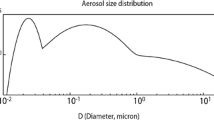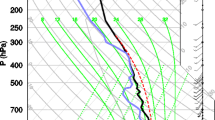Abstract
Aerosol effects on clouds and precipitation account for a large portion of uncertainties in the prediction of the future course of global hydrologic circulations and climate. As a process of a better understanding of interactions between aerosol, clouds and precipitation, simulations are performed for a mixed-phase convective multiple-cloud system over the tropics. Studies on single-cloud systems have shown that aerosol-induced increases in freezing, associated increases in parcel buoyancy and thus the intensity of clouds (or updrafts) are a main mechanism which controls aerosol–cloud–precipitation interactions in convective clouds. However, in the multiple-cloud system that plays much more important roles in global hydrologic circulations and thus climate than single-cloud systems, aerosol effects on condensation play the most important role in aerosol-induced changes in the intensity of clouds and the effects on freezing play a negligible role in those changes. Aerosol-induced enhancement in evaporation intensifies gust fronts and increases the number of subsequently developing clouds, which leads to the substantial increases in condensation and associated intensity of convection. Although aerosol-induced enhancement in freezing takes part in the increases in condensation by inducing stronger convergence around cloud bottom, the increases in condensation are ~one order of magnitude larger than those in freezing. It is found that while aerosol-induced increases in freezing create intermittent extremely heavy precipitation, aerosol-induced increases in evaporation enhance light and medium precipitation in the multiple-cloud system here. This increase in light and medium precipitation makes it possible that cumulative precipitation increases with increasing aerosol concentration, although the increase is small. It is interesting that the altitude of the maximum of the time- and domain-averaged hydrometeor mass densities is quite robust to increases in aerosol concentration. This is because locations of gust fronts and homogeneous freezing do not vary significantly with changing aerosol concentration and this outweighs aerosol effects on hydrometeor size.












Similar content being viewed by others
References
Abdul-Razzak H, Ghan SJ (2000) A parameterization of aerosol activation 2. Multiple aerosol types. J Geophys Res 105:6837–6844
Abdul-Razzak H, Ghan SJ (2002) A parameterization of aerosol activation—3. Sectional representation. J Geophys Res 107:4026. doi:10.1029/2001JD000483
Albrecht BA (1989) Aerosols, cloud microphysics, and fractional cloudiness. Science 245:1227–1230
Donner LJ, Seman CJ, Hemler RS (1999) Three-dimensional cloud-system modeling of GATE convection. J Atmos Sci 56:1885–1912
Fan J, Zhang R, Tao WK, Mohr K (2008) Effects of aerosol optical properties on deep convective clouds and radiative forcing. J Geophys Res 113:D08209. doi:10.1029/2007JD009257
Fan J, Yuan T, Comstock JM, Ghan SJ, Khain A, Leung LYR, Li Z, Martins VJ, Ovchinnikov M (2009) Dominant role by vertical wind shear in regulating aerosol effects on deep convective clouds. J Geophys Res. doi:10.1029/2009JD012352
Fan J, Leung LR, Li Z et al (2012) Aerosol impacts on clouds and precipitation in eastern China: results from bin and bulk microphysics. J Geophys Res 117:D00K36. doi:10.1029/2011JD016537
Fan J, Leung LR, Rosenfeld D et al (2013) Microphysical effects determine macrophysical response for aerosol impacts on deep convective clouds. Proc Natl Acad Sci USA 110:E4581–E4590. doi:10.1073/pnas.1316830110
Feingold G, Koren I, Wang H, Xue H, Brewer A (2010) Precipitation-generated oscillations in open-cellular cloud fields. Nature 466:849–852
Fridlind A et al (2009) ARM/GCSS/SPARC TWP-ICE intercomparison study. http://science.arm.gov/wg/cpm/scm/scmic6/index.html
Garrett TJ, Zhao C (2006) Increased Arctic cloud longwave emissivity associated with pollution from mid-latitudes. Nature 440:787–789
Garrett TJ, Zhao C, Novelli PC (2010) Assessing the relative contributions of transport efficiency and scavenging to seasonal variability in Arctic aerosol. Tellus B. 62:190–196. doi:10.1111/j.1600-0889.2010.00453.x
Houze RA (1993) Cloud dynamics. Academic Press, London
Khain AP (2009) Notes on state-of-the-art investigations of aerosol effects on precipitation: a critical review. Environ Res Lett. doi:10.1088/1748-9326/4/1/015004
Khain A, Rosenfeld D, Pokrovsky A (2005) Aerosol impact on the dynamics and microphysics of deep convective clouds. Q J R Meteorol Soc 131:2639–2663
Khain A, Benmoshe N, Pokrovsky A (2008) Factors determining the impact of aerosols on surface precipitation from clouds: an attempt at classification. J Atmos Sci 65:1721–1748
Koop T, Luo B, Tsias A, Peter T (2000) Water activity as the determinant for homogeneous ice nucleation in aqueous solutions. Nature 406:611–614
Koren I, Altaratz O, Remer LA et al (2012) Aerosol-induced intensification of rain from the tropics to the mid-latitude. Nat Geosci 5:118–122
Lee SS (2011) Dependence of aerosol-precipitation interactions on humidity in a multiple-cloud system. Atmos Chem Phys 11:2179–2196
Lee SS, Feingold G (2010) Precipitating cloud-system response to aerosol perturbations. Res. Lett, Geophys. doi:10.1029/2010GL045596
Lee SS, Feingold G (2013) Aerosol effects on the cloud-field properties of tropical convective clouds. Atmos Chem Phys 13:6713–6726
Lee SS, Donner LJ, Phillips VTJ, Ming Y (2008a) Examination of aerosol effects on precipitation in deep convective clouds during the 1997 ARM summer experiment. Q J R Meteorol Soc. doi:10.1002/qj.287
Lee SS, Donner LJ, Phillips VTJ, Ming Y (2008b) The dependence of aerosol effects on clouds and precipitation on cloud-system organization, shear and stability. J Geophys Res 113:D16202. doi:10.1029/2007JD009224
Lee SS, Donner LJ, Phillips VTJ (2009) Sensitivity of aerosol and cloud effects on radiation to cloud types: comparison between deep convective clouds and warm stratiform clouds over one-day period. Atmos Chem Phys 9:2555–2575
Lee SS, Donner LJ, Penner JE (2010) Thunderstorm and stratocumulus: how does their contrasting morphology affect their interactions with aerosols? Atmos Chem Phys 10:6819–6837. doi:10.5194/acp-10-6819-2010
Lee SS, Feingold G, Chuang PY (2012) Effect of aerosol on cloud–environment interactions in trade cumulus. J Atmos Sci 69:3607–3632
Li Z, Niu F, Fan J et al (2011) Long-term impacts of aerosols on the vertical development of clouds and precipitation. Nature Geosci 4:888–894
Lohmann U, Diehl K (2006) Sensitivity studies of the importance of dust ice nuclei for the indirect aerosol effect on stratiform mixed-phase clouds. J Atmos Sci 63:968–982
Lynn B, Khain A, Dudhia J, Rosenfeld D, Pokrovsky A, Seifert A (2005a) Spectral (bin) microphysics coupled with a mesoscale model (MM5). Part 1. Model description and first results. Mon Weather Rev 133:44–58
Lynn B, Khain A, Dudhia J, Rosenfeld D, Pokrovsky A, Seifert A (2005b) Spectral (bin) microphysics coupled with a mesoscale model (MM5). Part 2: simulation of a CaPE rain event with squall line. Mon Weather Rev 133:59–71
May PT, Mather JH, Vaughan G, Jakob C (2008) Characterizing oceanic convective cloud systems—the tropical warm pool international cloud experiment. Bull Am Meteorol Soc 154:153–155. doi:10.1175/BAMS-89-2-153
Mellor GL, Yamada T (1982) Development of a turbulence closure model for geophysical fluid problems. Rev Geophys 20:851–875
Mӧhler O, Field PR, Connolly P, Benz S, Saathoff H, Schnaiter M, Wagner R, Cotton R, Krämer M, Mangold A, Heymsfield AJ (2006) Efficiency of the deposition mode ice nucleation on mineral dust particles. Atmos Chem Phys 6:3007–3021. doi:10.5194/acp-6-3007-2006
Phillips VTJ, Donner LJ (2007) Cloud microphysics, radiation, and vertical velocities in two- and three-dimensional simulations of deep convection. Q J R Meteorol Soc 133:3011–3033
Phillips VTJ, Choularton T, Blyth A, Latham J (2002) The influence of aerosol concentrations on the glaciation and precipitation of a cumulus cloud. Q J R Meteorol Soc 128:951–971
Phillips VTJ, Donner LJ, Garner S (2007a) Nucleation processes in deep convection simulated by a cloud-system-resolving model with double-moment bulk microphysics. J Atrmos Sci 64:738–761
Phillips VTJ, Pokrovsky A, Khain A (2007b) The influence of time-dependent melting on the dynamics and precipitation production in maritime and continental storm clouds. J Atmos Sci 64:338–359
Pruppacher HR, Klett JD (1997) Microphysics of clouds and precipitation. D. Reidel, Dordrecht
Rogers RR, Yau MK (1991) A short course in cloud physics. Pergamon Press, Oxford
Rosenfeld D, Woodley WL (2000) Convective clouds with sustained highly supercooled liquid water down to −37° C. Nature 405:440–442. doi:10.1038/35013030
Rosenfeld D, Lohmann U, Raga GB et al (2008) Flood or drought, how do aerosols affect precipitation? Science 321:1309–1313
Saleeby SM, Cotton WR (2004) A large-droplet mode and prognostic number concentration of cloud droplets in the Colorado state university regional atmospheric modeling system (RAMS). Part I: module description and supercell test simulations. J Appl Meteorol 43:182–195
Sato T, Yoshikane T, Satoh M et al (2008) Resolution dependency of the diurnal cycle of convective clouds over the Tibetan Plateau in a mesoscale model. J Meteorol Soc Japan 85A:17–31
Seifert A, Beheng KD (2006) A two-moment cloud microphysics parameterization for mixed-phase clouds. Part 2: maritime vs. continental deep convective storms. Meteorol Atmos Phys 92:67–82
Shaw GE (1995) The Arctic haze phenomenon. Bull Am Meteorol Soc 76:2403–2413
Storer RL, van den Heever SC, Stephens GL (2010) Modeling aerosol impacts on convection under differing storm environments. J Atmos Sci 67:3904–3915. doi:10.1175/2010JAS3363.1
Tao W-K et al (2003) Microphysics, radiation and surface processes in the Goddard Cumulus Ensemble (GCE) model. Meteorol Atmos Phys 82:97–137
Tao W-K, Li X, Khain A, Matsui T, Lang S, Simpson J (2007) Role of atmospheric aerosol concentration on deep convective precipitation: cloud-resolving model simulations. J Geophys Res 112:D24S18. doi:10.1029/2007JD008728
Tao W-K, Chen J-P, Li Z, Wang C, Zhang C (2012) Impact of aerosols on convective clouds and precipitation. Rev Geophys 50:RG2001. doi:10.1029/2011RG000369
Twomey S (1977) The influence of pollution on the shortwave albedo of clouds. J Atmos Sci 34:1149–1152
van den Heever SC, Cotton WR (2007) Urban aerosol impacts on downwind convective storms. J Appl Meteorol Climatol 46:828–850. doi:10.1175/JAM2492.1
van den Heever SC, Stephens GL, Wood NB (2011) Aerosol indirect effects on tropical convection characteristics under conditions of radiative-convective equilibrium. J Atmos Sci 68:699–718
Wang Y, Wan Q, Meng W et al (2011) Long-term impacts of aerosols on precipitation and lightning over the Pearl river delta megacity area in China 11:12421–12436
Weisman ML, Klemp JB (1982) The dependence of numerically simulated convective storms on vertical wind shear and buoyancy. Mon Weather Rev 110:504–520
Xue H, Feingold G (2006) Large-Eddy simulations of trade wind cumuli: investigation of aerosol indirect effects. J Atmos Sci 63:1605–1622
Zhao C, Garrett TJ (2008) Ground-based remote sensing of precipitation in the Arctic. J Geophys Res 113:D14204. doi:10.1029/2007JD009222
Zhao C, Klein SA, Xie S, Liu X, Boyle JS, Zhang Y (2012) Aerosol first indirect effects on non-precipitating low-level liquid cloud properties as simulated by CAM5 at ARM sites. Geophys Res Lett 39:L08806. doi:10.1029/2012GL051213
Acknowledgments
This research is supported by Korea Environmental Industry & Technology Institute funded by the Korea Ministry of Environment as “Climate Change Correspondence Program” and the "Advanced Research on Applied Meteorology" of National Institute of Meteorological Sciences funded by the Korea Meteorological Administration (KMA). This research is also supported by the Basic Science Research Program through the National Research Foundation of Korea (NRF) funded by the Ministry of Education (2015R1D1A1A09059906).
Author information
Authors and Affiliations
Corresponding author
Rights and permissions
About this article
Cite this article
Lee, S., Kim, BG., Yum, S. et al. Effects of aerosol on evaporation, freezing and precipitation in a multiple cloud system. Clim Dyn 48, 1069–1087 (2017). https://doi.org/10.1007/s00382-016-3128-1
Received:
Accepted:
Published:
Issue Date:
DOI: https://doi.org/10.1007/s00382-016-3128-1




